U.S. Department of Transportation
Federal Highway Administration
1200 New Jersey Avenue, SE
Washington, DC 20590
202-366-4000
| < Previous | Table of Content | Next > |
It is generally acknowledged that non-motorized travel modes are not being used as extensively as they could be in the United States. This lesson describes current levels of bicycle and pedestrian activity, and specifically examines the reasons why bicycling and walking are not used more extensively as travel modes. Patterns of pedestrian and bicycle travel are explored, particularly as they relate to design issues and allocation of right-of-way space.
In order to adequately plan and design for bicycles and pedestrians, it is important to understand current patterns of travel as well as the desire for increased mobility. Although children, older adults, and the disabled make up a large percentage of the population (up to 37 percent of most States), their needs are seldom adequately considered in transportation system planning and design. This lesson discusses bicycle and pedestrian travel from the perspectives of these user groups. (FHWA-PD-94-023, National Bicycling and Walking Study)
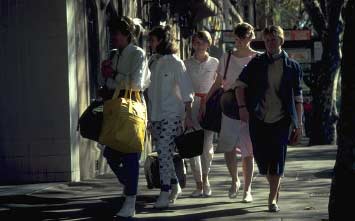
Bicyclists and pedestrians need to be accommodated with safe and convenient modes of transportation.
Bicycling and walking are clearly popular activities, whether for sport, recreation, exercise, or simply for relaxation and enjoyment of the outdoors. As the following surveys indicate, however, their potential as modes of transportation is just beginning to be realized.
The primary source of information on utilitarian as well as recreational bicycling and walking in the United States is the Nationwide Personal Transportation Survey (NPTS). The survey is conducted approximately every 7 years. The first three were home interview surveys; the 1990 survey was done by telephone. The survey is conducted throughout the year and includes information on the travel of persons age 5 and older.
The 1990 NPTS interviewed 48,385 persons living in 22,317 households (Research Triangle Institute, 1991). Each respondent was asked to provide information on all travel during a recent 24-hour period, including the purpose of the trip, distance traveled, and travel mode. Information was collected for each segment of multi-modal trips, such as a walk to a bus stop or bicycle ride to a rail station.
Results revealed that only one out of five trips involved travel to or from work, and less than 2 percent involved on-the-job travel. The largest portion of trips (42 percent) are family or personal business travel, which includes trips to the grocery store, to the doctor or dentist, or to transport a child to school. Social or recreational travel accounts for another quarter of trips. This category includes visits to friends or relatives, trips to a park or sporting event, as well as "pleasure driving" and vacation trips. Overall, 7.2 percent of all trips were by walking and 0.7 percent by bicycling.
The percentage of bicycling trips is essentially the same as reported in the 1983 NPTS results, while the percentage of walking trips is down slightly from 8.5 percent previously recorded (Klinger and Kuzmyak, 1986). The 1990 survey also showed walking to be a frequent component of multi-modal trips, although these accounted for only 1 percent of all trips. All totaled, an estimated 18 billion walking trips and 1.7 billion bicycling trips were made in 1990. (Research Triangle Institute, 1991)
More than half of the bicycle trips and a third of the walking trips were for social or recreational purposes. Family and personal business travel, along with school and church-related travel, were also significant contributors. Average length of a travel trip was 0.6 mile for walking, and 2.0 miles for bicycling. As expected, non-motorized modes were used to a greater extent in central city areas, with their higher densities and compactness, than in the suburbs or rural areas. More than 11 percent of all trips in central cities were by walking or bicycling.
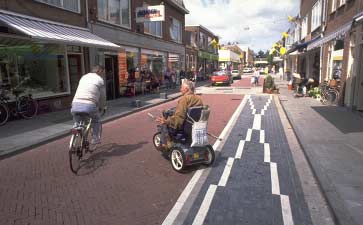 U.S.
Census Survey
U.S.
Census SurveyA second source of information on utilitarian bicycling and walking is the U.S. Census "Journey to Work" survey. The survey is conducted every 10 years and is targeted toward participants in the work force age 16 or older. It is important to note that the U.S. Census survey only reports on travel to and from work, excluding trips to school, shopping, and other frequent destinations. Data are collected for a one-week period during the last week in March, making it likely that bicycling and walking trips are underreported for many parts of the country due to cold weather. Moreover, only the predominant transportation mode is requested, so that occasional bicycling and walking trips as well as bicycling and walking trips, made to access transit or other travel modes, are not recorded.
With these limitations in mind, in 1990, an estimated 4.5 million people (4.0 percent of all workers) commuted to work by walking, and just under onehalf million (0.4 percent) commuted by bicycle. These are national averages; some cities had much higher percentages of people walking or bicycling to work. It should be noted, however, that the overall percentages for 1990 are down slightly from the 1980 Census results, which showed 5.3 percent of persons commuting by walking and 1.4 percent by bicycling.
Madison, Wisconsin; Portland and Eugene, Oregon; Davis, California; and Boulder, Colorado are all places that enjoy relatively high levels of bicycling and walking for transportation as well as recreation and fitness. These and other U.S. "success stories" will be documented in later chapters of this report. Considering these successes, as well as the high levels of bicycling and walking in many European cities, it is clear that the transportation potential of walking and bicycling in the United States has barely been tapped.
As examples, in Delft, The Netherlands, bicycles are used for 43 percent of all travel trips, and in Muenster, Germany, they are used for more than a third of all trips (The National Bicycling and Walking Study Case Study No. 16: Study of Bicycle and Pedestrian Programs in European Countries, FHWA-PD-92-037, 1992). Like the United States, Japan is a highly motorized society; in Tokyo, however, non-motorized transportation constitutes one-fourth of all travel. (Case Study No. 17)
These cities and many others in Europe, Asia, and other parts of the world provide strong evidence that bicycling and walking are more than just good ways of staying fit and enjoying the outdoors. They are modes of travel that can reduce the need for automobile trips and play an important role in the overall transportation system. (National Bicycling and Walking Study, FHWA Publication No. FHWAPD-94-023, 1991)
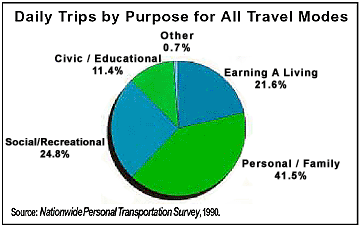
Source: Nationwide Personal Transportation Survey, 1990.
Many factors influence choice of travel mode and, in particular, the decision to bicycle or walk. These factors operate at different levels in the decision process. A recent analysis identified a three-tiered hierarchy of factors categorized according to initial considerations, trip barriers, and destination barriers.(The National Bicycling and Walking Study Case Study No. 1: Reasons Why Bicycling and Walking Are and Are Not Being Used More Extensively as Travel Modes, FHWA-PD-93-041, 1992)
Many people may never seriously consider the transportation options of bicycling
and walking. Overcoming the status quo of automatically relying on a car to
travel the 3 miles to work or three blocks to the drugstore is an important
first step in broadening the base of bicyclists and walkers. Activities such
as "Bike to Work" days have been successfully employed in many communities
to increase awareness of bicycling and walking as viable means of transport.
Distance, or its companion factor, time, is often sited as a reason for not
bicycling or walking. According to 1990 NPTS results, the average length of
a travel trip is 9 miles. Trips to work are slightly longer, while shopping
and other utilitarian trips are shorter. More importantly, 27 percent of travel
trips are 1 mile or less; 40 percent are 2 miles or less; and 49 percent are
3 miles or less. All of these trips are within reasonable bicycling distance,
if not within walking distance.
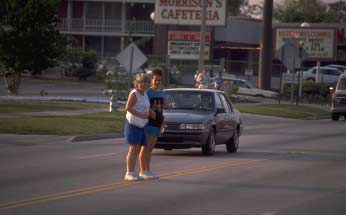 Individual
attitudes and values are also important in the decision to bicycle or walk.
People may choose not to bicycle or walk because they perceive these activities
as "uncool," as children's activities, or as socially inappropriate
for those who can afford a car. Others may have quite different values, viewing
bicycling and walking as beneficial to the environment, health, economical,
and free from the problems of contending with traffic or finding parking. These
and the many other benefits of bicycling and walking described in the previous
section are key motivators for many persons not only to begin bicycling and
walking, but also to continue to do so on a regular basis.
Individual
attitudes and values are also important in the decision to bicycle or walk.
People may choose not to bicycle or walk because they perceive these activities
as "uncool," as children's activities, or as socially inappropriate
for those who can afford a car. Others may have quite different values, viewing
bicycling and walking as beneficial to the environment, health, economical,
and free from the problems of contending with traffic or finding parking. These
and the many other benefits of bicycling and walking described in the previous
section are key motivators for many persons not only to begin bicycling and
walking, but also to continue to do so on a regular basis.
Individual perceptions (and mis-perceptions) also play a role in the decision process. Safety concerns such as traveling at night must be addressed. Although walking and bicycling can be accomplished at low levels of exertion, some people perceive that these activities are beyond their capabilities (The National Bicycling and Walking Study Case Study No. 4: Measures to Overcome Impediments to Bicycling and Walking, FHWA-PD-93-031, 1992). While a very small proportion of the population may not have the physical capabilities to walk to a destination or ride a bicycle, for most people, these activities are well within their abilities, and as stamina and skill increase, such activities become easier and more enjoyable.
Finally, there are situational constraints that, while they may not totally preclude the decision to bicycle or walk, do require additional planning and effort. Examples include needing a car at work, having to transport items that are heavy or bulky, and needing to drop off children at day-care. While these situations may make it more difficult to bicycle or walk, they often can be overcome with advance planning. More analysis of these issues would be useful. If bicycling and walking are not appropriate for one particular trip, a number of trips in which bicycling and walking are viable options are usually present during the course of a day or week.
Even with a favorable disposition toward bicycling and walking, reasonable trip distances, and absence of situational constraints, many factors can still encourage or discourage the decision to bicycle or walk. One of the most frequently cited reasons for not bicycling or walking is fear for safety in traffic (Case Study No. 4). Given the prevailing traffic conditions found in many urban and suburban areas -narrow travel lanes, high motor vehicle speeds, congestion, lack of sidewalks, pollution, etc.-many individuals who could meet their transportation needs by bicycling or walking do not, simply because they perceive too great a risk to their safety and health.
Perceptions of safety as well as actual safety problems must be addressed at the local level. Locational constraints such as lack of alternatives to high-speed, high motor vehicle volume roadways must be carefully handled. Adequate facilities can help overcome many of these safety concerns, whether they be sidewalks for walking, smooth shoulders, wide curb lanes, bicycle lanes, or off-road paths for the enjoyment of both bicyclists and walkers. Traffic-calming measures are another way to enhance bicycle and pedestrian safety and accommodation.
Traffic safety can also be improved through education and law enforcement activities.Training
opportunities that help bicyclists feel more competent riding in traffic, campaigns
that remind motorists to "share the road," and efforts to cite motorists
who fail to yield to pedestrians at intersections are just a few examples.
Even communities with well-designed bicycling and walking facilities can still
be plagued by problems with access and linkage. A beautifully designed and constructed
off-road facility is useless to the bicyclist or pedestrian who cannot traverse
a narrow bridge or cross a freeway to get to it. Similarly, facilities that
do not connect neighborhoods to shopping areas or downtown businesses may never
achieve their intended purpose of increased use of non-motorized travel modes.
Directness of the route and personal safety and security considerations are
also important factors in people's decisions to bicycle or walk.
Environmental factors could also be considered in this category of trip barriers. Examples include hilly terrain, extreme temperatures, high humidity, and frequent or heavy rainfall. Like many of the other trip barriers cited, these are to a great extent subjective and have been dealt with by those already engaging in these activities, any of whom have effectively overcome these difficulties. For potential users, these issues must be addressed and overcome if that is possible.
Facility and infrastructure needs do not stop with arrival at the work site or other destination. Many bicyclists are discouraged from becoming bicycle commuters because once at work they have no place to safely park their bicycle and no place where they can shower and change (although if the trip is made at lower levels of exertion, showering and changing clothes may not be necessary). The absence of showers and changing facilities can also serve as a barrier to those wanting to incorporate a walk or run into their daily work commute or lunch break.
Secure bicycle parking deserves special attention. The availability of parking is a prerequisite for automobile use; the same holds true for bicycling. Bicyclists are further burdened by the possibility of theft or damage to their bicycles. A Baltimore survey of bicyclists reported that 25 percent had suffered theft, with 20 percent of those giving up bicycling as a result. In New York City, bicycle theft numbers in the thousands annually. Even when parked securely, bicycles are frequently exposed to damage from rain and other environmental conditions. Secure parking areas for bicycles are necessary before bicycle use will increase.
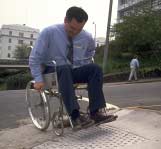
Even communities with well-designed bicycling and walking
facilities can still have problems with access and linkage.
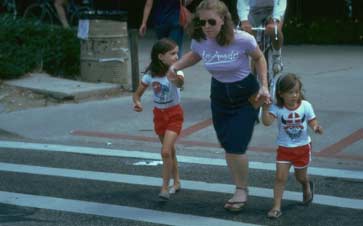
Law enforcement officials can increase motorists awareness of pedestrian
safety by penalizing city motorists who fail to yield to pedestrians.
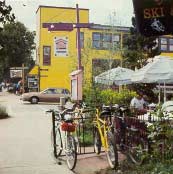
Secure bike parking is necessary before bicycle use will
increase.
What is the potential for increasing bicycling and walking in the United States?
Can the relatively high levels of bicycling and walking found in cities such
as Davis, California and Madison, Wisconsin be duplicated in other communities?
Can U.S. cities approach the high usage levels found in some European and Asian
cities?
Clearly, if aggregate levels of bicycling and walking are to be increased, changes must occur to remove the barriers previously discussed. This section identifies a variety of factors that impact on the potential of bicycling and walking as viable transportation modes in the United States. Together, they form a basis for the action plans presented in the remainder of the report.
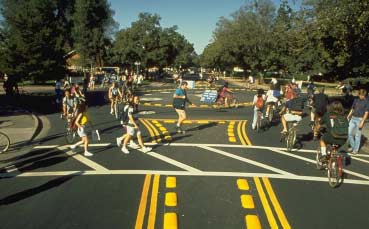
A 1991 Harris Poll showed that 82 million Americans had ridden a bicycle
in the previous year.
As mentioned in the previous chapter, the public already strongly supports increased travel options. The 1991 Harris Poll cited earlier showed that 46 percent of adults age 18 and older — 82 million Americans — had ridden a bicycle in the previous year. Of these:
Other Considerations
Other factors can also significantly impact on the potential for bicycling and
walking in the United States. Of particular relevance are: (1) the linkage of
bicycle and pedestrian travel to transit, (2) the expansion of recreational
bicycling and walking to more utilitarian uses, and (3) the potential impact
of bicycle design technology.
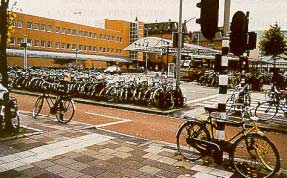 A fleet of bicycles await their owners at this Dutch bus terminal. |
The transit connection.
An important outgrowth of the ISTEA legislation is the creation of an
Office of Intermodalism within the U.S. Department of Transportation. This office
has primary responsibility for coordination between the different modes of transportation.
In the past, intermodal research, planning, and programs attracted relatively
little attention in the United States, in part because transportation agencies
are organized along modal lines. The recent legislation offers new opportunities
and strong encouragement for transportation agencies to work together to improve
pedestrian and bicyclist access to public transportation. (The National Bicycling
and Walking Study Case Study No. 9: Bicycle and Pedestrian Policies
and Programs in Asia, Australia, and New Zealand, FHWA-PD93-016,
1992) The potential for bicyclist and pedestrian integration with transit is
enormous. According to 1990 NPTS data, 53 percent of all people nationwide live
less than 2 miles from the closest public transportation route. The median length
of an automobile trip to access a park-and-ride lot for public transit is 2.3
to 2.5 miles; and for a kiss-and-ride trip in which a passenger is dropped off,
median trip length ranges from 1.3 to 1.6 miles. (Case Study No. 9)
Since these short-distance "cold-start" motor vehicle trips generate significant pollution, improved bicyclist and pedestrian access to transit can also reap environmental benefits. A 1980 Chicago area transportation study found bike-and-ride to be by far the most cost-effective means of reducing hydrocarbon emissions. Results of recent studies indicate that if only 0.5 percent out of every 200 workers living less than 2 miles from a transit route and currently commuting by auto could be attracted to bike-and-ride travel, nationwide gasoline savings of 20 to 50 million gallons would be realized annually. The conversion of only 10 percent of park-and-ride commuters to bike-and-ride could result in gasoline savings of more than 2.2 million gallons annually. (Case Study No. 9)
While much potential remains unrealized, the bicycletransit link is gaining momentum:
Recreational bicycling and walking.
The popularity of bicycling and walking as recreational activities,
as well as healthy forms of outdoor exercise, is well documented. Over the past
decade, both activities have enjoyed widespread and growing participation by
the American public. The distinction between recreational bicycling and walking
and utilitarian bicycling and walking is not always clear-cut. One approach
is to classify a bicycle or walking trip as "utilitarian" only if
it would otherwise have been made by an alternative mode of transport, such
as a car or bus (the "mode substitution" test). By this definition,
the age of the person and the nature of the facility on which the travel takes
place do not enter into consideration. If a child rides a bicycle, even on the
sidewalk, down the street to a friend's house, this is a legitimate transportation
trip.
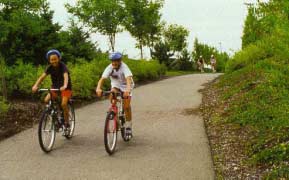 The
blending of recreational and transportation trip purposes and facilities is
perhaps best evidenced by the Rails-to-Trails movement. The idea behind the
movement beginning in the mid-1960's was simple: to convert abandoned or rail
corridors into public trails (Nevel and Harnik, 1990). The first trails were
little more than unpaved and ungraded stretches of "scrap land" used
primarily by hikers and casual walkers. However, over time, they evolved into
more finely tuned facilities, often paved, and immensely popular with the new
breed of mountain-bike riders and joggers. Today, there are nearly 3,000 miles
of such linear greenways, with an estimated 27 million users each year.
The
blending of recreational and transportation trip purposes and facilities is
perhaps best evidenced by the Rails-to-Trails movement. The idea behind the
movement beginning in the mid-1960's was simple: to convert abandoned or rail
corridors into public trails (Nevel and Harnik, 1990). The first trails were
little more than unpaved and ungraded stretches of "scrap land" used
primarily by hikers and casual walkers. However, over time, they evolved into
more finely tuned facilities, often paved, and immensely popular with the new
breed of mountain-bike riders and joggers. Today, there are nearly 3,000 miles
of such linear greenways, with an estimated 27 million users each year.
Trails serve a variety of purposes - environmental conservation, habitats for wildlife, and educational resources, as well as preservation of the rail corridors themselves. But beyond these uses, they also serve as a valuable system of urban corridors for bicycling, walking, and other forms of non-motorized transportation.
Despite the tremendous growth in the Rails-to-Trails program over the past
two decades, the market remains virtually untapped. Only about 2 percent of
the total mileage of track abandoned in this century has been converted to trails.
Nearly 150,000 miles of abandoned track remain available for development, and
much of this is located in urban areas. The rails-to-trails movement thus holds
tremendous potential for recreational as well as utilitarian bicycling and walking.
The kinds of grassroots efforts that make rails-to-trails conversions a reality
are typical of the actions of bicyclists across the country, who over the past
two decades have been organizing in a variety of ways to improve their acceptance
and safety on the roadway. From national groups such as the 23,000- member League
of American Bicyclists (LAB) and 25,000-member Adventure Cycling Association,
to State-level bicycle advisory boards and local bicycle clubs, there is already
in place an extensive network of resources to support current efforts to increase
levels of utilitarian bicycling. While pedestrians have not organized themselves
to the same extent as bicyclists, the potential exists here as well, as evidenced
by Prevention magazine's 70,000+-member America Walks and local groups
such as Walk Boston.
According to the Bicycle Federation of America, there are already an estimated
131 million recreational bicyclists and walkers. These people have demonstrated
their ability to travel under their own power. They have also experienced firsthand
the fitness, health, psychological, and other benefits of bicycling and walking.
This population will be instrumental in achieving the goal of doubling the percentage
of utilitarian bicycling and walking.
The primary question that remains is how to convert more of these recreational
bicyclists and walkers to persons using these modes for utilitarian travel.
The 1991 Harris Poll suggests that at least part of the answer lies in improving
existing facilities for bicycling and walking, building sidewalks and designated
bicycle facilities, installing secure bicycle parking at destinations, etc.
(Pathways for People, 1991). Other surveys support this conclusion (Robinson,
1980). However, it is uncertain to what extent a person's professed intention
to bicycle or walk if certain facilities are made available will correspond
to actual changes in their travel behavior should these improvements be realized.
Nevertheless, recreational bicyclists and walkers represent a strong candidate
pool of potential bicycling and walking commuters.
Indications that efforts to increase overall levels of bicycling and walking transportation will succeed come from analyses of successful efforts in this country and abroad. Much of the remainder of this report is devoted to documenting these successes and showing how the results can be expanded to other areas.
Bicycle design technology.
Another factor that may affect the potential of bicycling is the continued
development of the bicycle itself, along with the many accessories that accompany
it. The resurgence of bicycling in the 1980's may be partially credited to the
development of mountain bikes. Technological innovations and highly functional
design have made this type of bicycle "user-friendly" and versatile
for a wide range of people and uses. New bicycle designs -some of which are
just now appearing-that are appropriate for facilitating transit interface,
short distance cargo carrying, and easy use by all segments of society, may
further broaden ridership. Perhaps an even more "intelligent" bicycle
design can contribute to a significant increase in utilitarian bicycle trips.
(National Bicycling and Walking Study, FHWARD- 94-023, 1994).
An increasing percentage of the U.S. population is affected if pedestrians and bicyclists are not accommodated in transportation facilities and programs. Children, older adults, and people with disabilities make up a substantial portion of the population-up to 37 percent in some States. To maintain independence and mobility, these people walk and ride bicycles.
More than other age groups, children and older adults (age 66+) rely on walking or bicycling as their primary transportation mode. They have few options in most cases. They must achieve mobility within the physical limitations associated with old age and with the early stages of children's physical development:
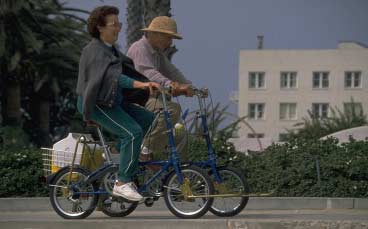
Children and older adults are highly overrepresented in bicycling and pedestrian crash statistics. Approximately 6,500 pedestrians and 900 bicyclists are killed each year as a result of collisions with motor vehicles. As a group, pedestrians and bicyclists comprise more than 14 percent of all highway fatalities each year. Pedestrians account for as much as 40 to 50 percent of traffic fatalities in some large urban areas.
Populations at both ends of the age spectrum are increasing as one wave of Baby Boomers nears retirement age and a new Boom is said to be in the works. Clearly, there is a need for action. (Pedestrian and Bicyclist Safety and Accommodation Participant Workbook, FHWA-HI-96-028, 1996)
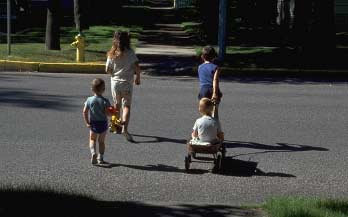 Children have not yet acquired the skills needed for traffic safety. |
Klinger, D., and Kuzmyak, J.R., Personal Travel in the United States, Vol. II 1983-1984 Nationwide Personal Transportation Study, Washington, DC: FHWA, September 1986.
National Bicycling and Walking Study, FHWA-RD- 94-023, 1994. The National Bicycling and Walking Study Case Study No. 4: Measures to Overcome
Impediments to Bicycling and Walking, FHWA Publication No. FHWA-PD-93-031, 1992.
The National Bicycling and Walking Study Case Study No. 16: Study of Bicycle and Pedestrian Programs in European Countries, FHWA-PD-92-037, 1992.
Nevel, B., and Harnik, P., Railroads Recycled, Washington, DC: Rails-to-Trails Conservancy, 1990.
Pathways for People, Rodale Press, Inc., Emmaus, PA, June 1992.
Pedestrian and Bicyclist Safety and Accommodation Participant Workbook, FHWA-HI-96-028, 1996.
Robinson, F., Edwards, J., and Ohrn, C., Strategies for Increasing Levels of Walking and Bicycling for Utilitarian Purposes, Transportation Research Record 743, Washington, D.C.: Transportation Research Board, 1980.
Sports Participation in 1990, National Sporting Goods Association, Mt. Prospect, IL: NSGA, 1991.
| < Previous | Table of Content | Next > |
